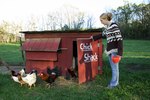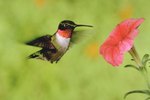
A rooster's role is to protect, mate with and provide for his flock. To do this, he must be able to communicate with other roosters, hens, chicks and even with predators. While a rooster crowing in the morning might sound like nothing but a noisy sunrise alarm to us, he's busy delivering important information to members of his own species.
Territory
Although chickens and roosters on farms don't tend to venture too far, the rooster crows or calls in an effort to keep in communication with his flock and let other roosters know he is there. This habit is believed to have originated when chickens lived in jungles in Asia and couldn't always see each other as they traveled through the vegetation. Crowing lets a rooster's hens know where he is, and tells other roosters that the territory is taken. Domesticated roosters that have plenty of space to themselves, such as on neighboring farms, often crow back and forth to communicate that they've established their territory.
Dominance
To keep his flock, a rooster must prove that he is in control. He uses a crowing sound to establish his dominance over other roosters and his group of hens. The crowing signals that not only is the area his territory, but he is in charge of it. When another fowl, or sometimes any other animal, vehicle or person, enters his territory, he crows in an attempt to show that he is the dominant bird.
Food
When a rooster finds some food that he thinks his flock of hens would enjoy, he doesn't take it all for himself. Instead, he makes an unusual gurgling noise. The hens react by running to the rooster to see what he has found. If it is a single treat, like a lone grasshopper, the rooster may pick it up and place it in the beak of a single hen. His gurgling call lets the hens know that they should come to his side as quickly as possible.
Danger
A rooster always is on the lookout for danger. If he spots anything that he thinks might be dangerous to his flock, like a hawk or a hungry coyote, he lets out a high-pitched warning call. This call tells the hens, chicks and younger roosters to head to a safe place. He may even use his loud call or a crowing sound as a diversion to lure a dangerous predator away from the rest of the group.
Mating
A rooster may use vocal communications to call his hens to him, but he uses a dance to encourage them to mate with him. During the dance, he will extend and dip one wing and then prance in a circle, keeping the lowered wing on the inside of the circle. This behavior communicates to the hens that he is ready to mate. A hen often will respond by crouching down and bobbing her head.
References
Resources
Photo Credits
-
Photos.com/Photos.com/Getty Images



